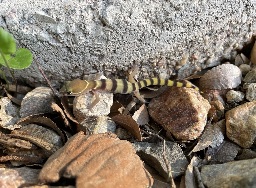Western Banded Gecko (Coleonyx variegatus)
Description: The western banded gecko is a terrestrial lizard, ranging in total length (including tail) from 4–6 inches. The body of the western banded gecko (excluding the tail) rarely grows past 3 inches in length. Hatchlings measure 1 inch. The body is sandy-colored with dark crossbands broken into patches. The tiny scales give its skin a silky texture. Unlike typical geckos, it has prominent eyes with movable lids. The male reptiles of this species have noticeable spurs on both sides of the body located at the base of the tail.
Habitat: The western banded gecko is found in a wide range of habitats, including creosote bush and sagebrush desert, pinyon-juniper woodland, and catclaw-cedar-grama grass associations in the eastern part of its range and chaparral areas in the west. Its elevational range extends from below sea level to about 4,990 feet asl. The species commonly lives in open and arid deserts and grasslands. The substrate in which the species lives ranges from rocky and sheltered areas to sandy dunes and arroyos.
Range: In the United States, C. variegatus is found in Arizona, southern California, southwestern New Mexico, Nevada, and Utah. In California, it is found in the Mojave and Sonoran deserts In Mexico, it is found in northwestern Baja California and Sonora.
Diet: C. variegatus preys on small insects and spiders, and is one of the few reptiles that control scorpion populations by eating baby scorpions
Reproduction: The Western banded geckos breed during the months April and May. During the months of May through September, the female western banded geckos will lay one to three clutches of eggs. Each clutch of eggs contains two eggs. The eggs will then hatch in approximately 45 days.
Status: Listed as Least Concern in view of its wide distribution, presumed large population, and because it is unlikely to be declining fast enough to qualify for listing in a more threatened category.
»» Kingdom: Animalia - Animals
»» Phylum: Chordata - Chordates
»» Subphylum: Vertebrata - Vertebrates
»» Class: Reptilia - Reptiles
»» Order: Squamata - Lizards
»» Family: Gekkonidae - Geckos
»» Genus: Coleonyx
»» Species: Coleonyx variegatus - Western Banded Gecko
»» Subspecies:
»» San Diego Banded Gecko - ( Coleonyx variegatus abbotti)
»» Sonoran Banded Gecko - ( Coleonyx variegatus sonoriensis)
»» Desert Banded Gecko - ( Coleonyx variegatus variegatus)
»» Tucson Banded Gecko - ( Coleonyx variegatus bogerti)
»» Utah Banded Gecko - ( Coleonyx variegatus utahensis)
This article uses material from the Wikipedia article "Western Banded Gecko", which is released under the Creative Commons Attribution-Share-Alike License 3.0. Content may have been omitted from the original, but no content has been changed or extended.
|








